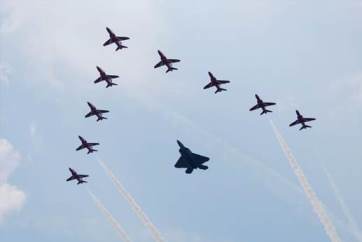Prof. HUANG Jie, Department of Mechanical and Automation Engineering
The Certainty Equivalence Principle and the Cooperative Control of Networked Systems with its Applications (GRF $844,559)
Many living beings tend to perform collective behaviours such as the school of fish, swarm of locusts. The collective behaviours of living beings have inspired many engineering applications such as the formation of mobile robots, multiple spacecraft attitude alignment, mobile sensor area coverage, and control of electric power grids. Figure 3 (www.crutchfield.com) shows the formation of flights. These engineering applications have further led to the emerging research topic: cooperative control of networked multi-agent systems which possesses such advantages as simplicity, low cost and robustness against various uncertainties.
What makes the cooperative control of multi-agent systems challenging is that the control law has to be distributed in order to satisfy communication constraints. After extensive research on networked multi-agent systems for over a decade, the emphasis of the research is now placed on tackling complex networked systems subject to switching communication topologies. Currently, the PI of this project is developing a certainty equivalence control approach to handling general networked systems. This approach is based on two premises. First, the control problem of each pair of follower and leader is solvable by a conventional control law utilizing the output of this pair of the leader and the follower. The collection of all these individual control laws is called a purely decentralized control law for the networked system. Second, a so-called adaptive distributed observer for the leader system exists which is able to provide the estimation of both the leader's signal and the leader's dynamics to each follower for feedback control without knowing the global information of the leader. Under these two premises, a distributed control law can be synthesized by replacing the leader's signal in the purely decentralized control law with the estimated leader's signal provided by the adaptive distributed observer. Such designed distributed control law is called certainty equivalence distributed control law. If the certainty equivalence distributed control law can accomplish the same task as the purely decentralized control law, then this control law is said to satisfy the certainty equivalent principle. The success of this design philosophy depends on two key issues: the existence of the adaptive distributed observer and the satisfaction of the certainty equivalence principle. So far, we have partially addressed the first issue in that we have already developed an adaptive distributed observer that is valid for undirected switching communication networks. However, the assumption that the communication network is undirected precludes many practical applications, it is imperative to remove this restrictive assumption. The challenge with the second issue is that the certainty equivalence principle is only guaranteed for linear time-invariant systems. As we will handle nonlinear systems or linear systems subject to directed switching communication networks, we need to establish the certainty equivalent principle for more complex tasks such as rendezvous / flocking with connectivity preservation and for more complex systems such as Euler-Lagrange systems and rigid-body systems subject to directed switching communication networks. Thus, in this project, the PI will develop a full-fledged certainty equivalence control design framework with the following three specific objectives:
- Establish the adaptive distributed observer subject to directed switching networks.
- Develop the certain equivalence control design framework for dealing with such problems as consensus/formation problem of networked robotic systems and networked rigid-body systems, and the rendezvous / flocking of double-integrator systems and Euler-Lagrange systems
- Evaluate and validate the general results by specific applications such as the formation of mobile robots, attitude synchronization of spacecraft, and networked manufacturing systems.
Prof. CHEN Nan, Department of Systems Engineering and Engineering, CUHK
Simulation from Characteristic Functions (GRF Grant $744,177)
Prof. CHEN proposes to use a variety of modelling and computational methodologies from mathematics and engineering, in particular stochastic analysis, network, and Monte Carlo simulation, to develop tools to measure, mitigate, and manage the systemic risk. Observing that a defaulting institution behaves in much the same manner as a ``bottleneck" node in a stochastic network, he and Prof. David Yao from Columbia University innovatively transplanted a host of well-established approaches and known results in stochastic networks to investigate financial network. The new work is appearing in Operations Research, the flagship journal of the field. Now they are striding to transforming the theoretical result to implementable risk metrics to help regulators to better monitor the stability of financial systems.
He has won supports from General Research Fund, Hong Kong Research Grant Council for six times since 2006. Prof. CHEN's research interest currently focuses on the study of financial systemic risk, the risk that failures of individual or several institutions cause the collapse of the entire system. In a modern financial market, institutions knit a complex network through active borrowing-and-lending activities and holding significant amount of marketable securities against each other. In normal times, this network helps the institutions diversify their idiosyncratic risks to achieve an efficient allocation of economic resources. However, as shown by the global financial crisis of 2007-09 and its aftermath, this network can be easily turned into a conduit that propagates failures at one or several institutions to the entire system.
|
|

|
Figure 3. Formation of flights
|
|
|
